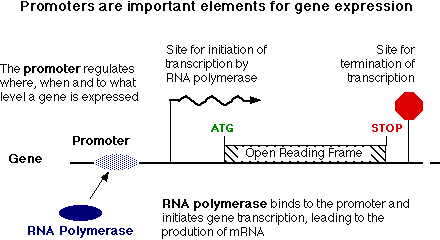A promoter is a regulatory region of DNA located upstream (towards the 5' region) of of a gene, providing a control point for regulated gene transcription.

PROMOTER ELEMENTS
1. Core promoter - the minimal portion of the promoter required to properly initiate transcription
Transcription Start Site (TSS)
Approximately -34
A binding site for RNA polymerase
General transcription factor binding sites
2. Proximal promoter - the proximal sequence upstream of the gene that tends to contain primary regulatory elements
Approximately -250
Specific transcription factor binding sites
Difference between Eukaryotic and Prokaryotic Promoters
Prokaryotic promoters
In prokaryotes, the promoter consists of two short sequences at -10 and -35 positions upstream from the transcription start site.
The sequence at -10 is called the Pribnow box, or the -10 element, and usually consists of the six nucleotides TATAAT. The Pribnow box is absolutely essential to start transcription in prokaryotes.
The other sequence at -35 (the -35 element) usually consists of the six nucleotides TTGACA. Its presence allows a very high transcription rate.
Eukaryotic promoters
Eukaryotic promoters are extremely diverse and are difficult to characterize. They typically lie upstream of the gene and can have regulatory elements several kilobases away from the transcriptional start site. In eukaryotes, the transcriptional complex can cause the DNA to bend back on itself, which allows for placement of regulatory sequences far from the actual site of transcription. Many eukaryotic promoters, contain a TATA box (sequence TATAAA), which in turn binds a TATA binding protein which assists in the formation of the RNA polymerase transcriptional complex. The TATA box typically lies very close to the transcriptional start site (often within 50 bases).


